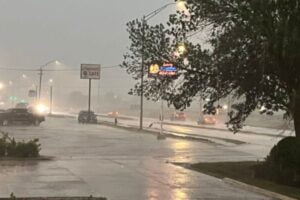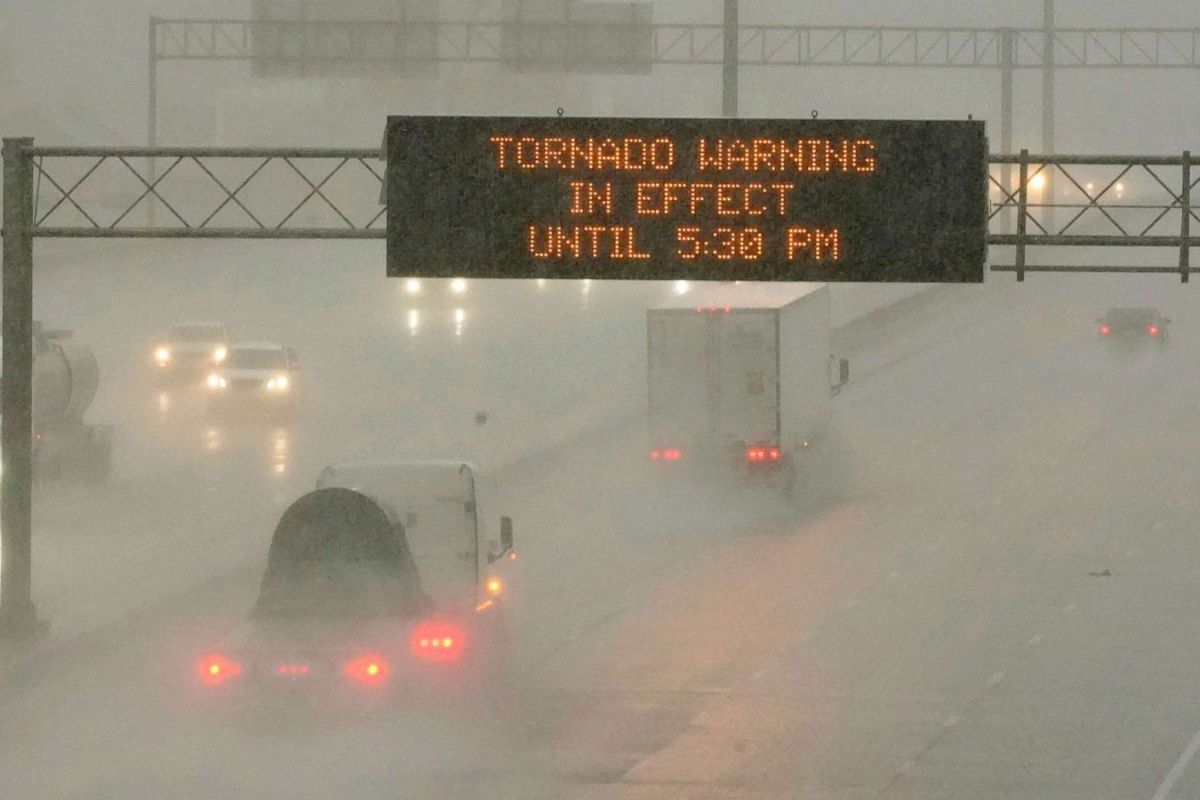Ensure Safety: Receive Up-to-Date Severe Weather Notifications & Expert Advice on Lightning and Wet Conditions Protection
The National Weather Service issued an updated severe storm warning at 6:32 AM on Monday, valid until 6:45 AM for Baldwin, Clarke, Escambia, and Monroe counties.Up to 60 miles per hour winds and hail the size of quarters are possible during this storm.
In Austin, a car collided with a building due to the storm.
According to the Weather Service, “At 6:32 AM, a fast-moving storm is coming from the east, 6 miles northwest of Uriyah, or 11 miles southwest of Frisco City, moving east at 50 miles per hour.” “There’s a concern for vehicle damage from hail. There’s also a concern for damage to roofs, siding, and trees due to the winds.”
The warning is for Uriyah.
The Weather Service advises, “For your safety, go to an interior room on the lowest floor of a building.”
When lightning strikes: Expert safety tips for thunderstorms
Nearly 25 million lightning strikes occur in the United States every year, with most occurring during the summer months. Unfortunately, according to the Weather Service report, lightning claims the lives of about 20 people each year. As storms approach, the risk of lightning-related incidents increases, peaking when the storm is directly overhead. However, as the storm moves away, the risk gradually decreases.
“To safeguard yourself during a thunderstorm, it’s crucial to heed the following suggestions:”
- Lightning Safety Plan:
- It’s essential to have a clear plan in place to seek shelter when outdoors during lightning storms.
- Stay vigilant for ominous signs in the sky and listen for the clear sound of thunder. If thunder is heard, lightning is nearby.
- Find a safe place of shelter, especially indoors.
- Indoor Safety Measures:
- Once you’ve found shelter indoors, avoid using corded phones, electrical appliances, or plumbing fixtures, and stay away from windows and doors.
- Following electrical paths can be hazardous, so steer clear of electrical wiring and plumbing during storms.
- Wait for everything to clear:
- After the last lightning strike or rumble of thunder, wait at least 30 minutes before resuming outdoor activities.
- Lightning can strike even after the storm has passed, so remain cautious.
When indoor shelter isn’t available:
If you find yourself caught outside during a thunderstorm and can’t reach indoor shelter, take these steps to maximize your safety:
- Avoid open fields, hilltops, or mountain ridges, as they increase your risk of being struck by lightning.
“Keep a safe distance from towering solitary trees and any other conspicuous structures.”In wooded areas, stay near lower trees.
- If you’re with a group, ensure that individuals are spread out to prevent the flow of lightning between people.
- Camping in open areas during a storm is strongly discouraged. If no other options are available, set up camp in a valley, ravine, or other lower areas.It’s important to keep in mind that tents cannot shield you from lightning.
- Avoid bodies of water, wet objects, or metallic objects. Metal and water don’t attract lightning, but they do conduct electricity well and can be very dangerous.
“Ultimately, the key to safeguarding yourself against the dangers of lightning lies in thorough preparation and unwavering vigilance.” By heeding these recommendations, you not only prioritize your safety but also significantly reduce the likelihood of encountering lightning-related incidents.”
Walking on rainy roads: Safety tips for wet weather
Extended periods of heavy rainfall or excessive runoff can lead to flooding. Excessive runoff saturates the soil and increases the intensity of rainfall. To stay safe during heavy rain, follow these recommendations from the weather service:

Be cautious of fast-moving water:
- Avoid parking or walking near bridges or drainage ditches during heavy rain, as rapidly flowing water can sweep you away.
Maintain a safe following distance:
During torrential downpours, it’s imperative to extend this following distance for added safety measures.” for reduced traction and braking effectiveness.
Reduce speed and drive cautiously:
- On wet roads, slowing down is paramount. Gradually reduce acceleration and avoid sudden braking to prevent skidding.
Choose your lane wisely:
in the outer lanes, potentially increasing the risk of hydroplaning or loss of control. Staying in the middle lane helps mitigate these hazards and promotes safer driving conditions.”
Visibility matters:
- Turn on your headlights and stay alert for other vehicles, especially in areas with reduced visibility due to heavy rain. Seeing through rain-splattered windows or glare from headlights can be particularly challenging.
Watch out for slippery roads:
- The first half-hour of rain is when roads are at their dirtiest due to the mix of rain, dirt, and oil. Exercise extra caution during this period.
Maintain a safe distance from large vehicles:
- Avoid following large trucks or buses too closely. Spray from their large tires reduces visibility. Exercise caution when passing them; if you must overtake, do so quickly and safely.
Keep an eye on your windshield wipers:
- Heavy rain can put a strain on windshield wipers. When visibility becomes too limited to see the road’s edges or other vehicles safely, pull over and wait for the rain to ease. Pulling off to rest areas or other protected areas is best.
- If the roadside is your only option, advance beyond the guardrail if possible and wait for the storm to pass. Keep your headlights on and flash emergency lights to alert other drivers to your presence.
Al News:https://www.al.com/

